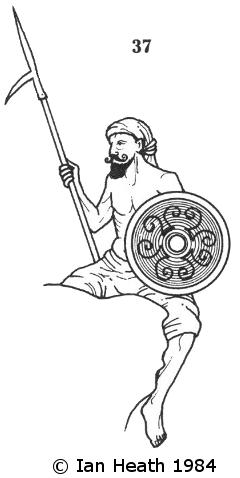Try Amazon Audible Plus

Join Amazon Prime - Watch Thousands of Movies & TV Shows Anytime - Start Free Trial Now
HINDU INDIAN MAHOUT
An extract from Armies of the Middle Ages, Volume 2
by Ian Heath
[Based on 'Battle between the sons of Sabuktagin, Mahmud and Ismaïl' in Jami' al-Tawarikh by Rashid al-Din, 1305-14AD]

37. HINDU INDIAN MAHOUT
Indian mahouts are invariably depicted unarmoured in Hindu sculpture of this period, even in battle-scenes, despite the fact that 12th-15th century Persian pictures frequently show armour being worn, while the written accounts repeatedly refer to it.
Varthema, for instance, refers in 1504 to mahouts being ‘armed with shirts of mail’, while Nikitin of Tver, who travelled in India in 1468-74, writes of mahouts ‘in full armour’.
However, the number of references in the sources to mahouts being killed in battle (see page 78) would tend to refute claims of ‘full armour’ being worn.
My own view is that whereas Hindu mahouts were largely unarmoured, those employed by the Moslems were generally armoured as described and depicted in contemporary accounts.
The particular figure portrayed here, from a battle-scene in Raschid al-Din’s ‘World History’, is typical of the unarmoured mahouts to be found in Hindu art (compare to the mahout in figure 166), his only defence being a cane shield.
He wears a white dhotti (mahouts seem to have customarily worn white) and a small white turban, which are referred to by Barbosa as being worn by the Hindus of the Deccan and Vijayanagar.
Though it seems likely that mahouts were armed in some way probably with javelins this figure carries only his elephant goad, which, as Pero Tafur tells us, was used to steer the elephant by pricking him behind the ears, ‘for the skin is very tender there’.
Next: 38. HINDU INDIAN CAVALRYMAN in Armies of the Middle Ages, Volume 2 by Ian Heath
Vijayanagar Illustrations and Articles
Mughal Illustrations of Costume & Soldiers


